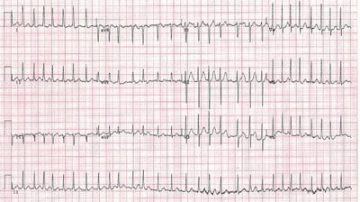Definitions Presumed source with SIRS criteria = infection Infection with life-threatening organ dysfunction = sepsis Sepsis refractory to intravenous fluid challenge = septic shock Treatment of sepsis or septic shock Draw blood cultures x 2 Analyze any fluid that may…
Read MoreAlthough pulmonary embolism (PE) occasionally presents with syncope, patients with syncope are infrequently assessed for PE. In this prospective study from Italy, researchers determined the prevalence of PE in 560 elderly adults (mean age, 76) who were hospitalized for their…
Read MoreIn prior randomized trials, the incidence of intracerebral hemorrhage (ICH) was significantly lower with the new oral anticoagulants (NOACs) than with warfarin (Blood 2014; 124:1968). However, it remains unclear if clinical outcomes are similar when ICH does occur with different…
Read MoreEvery four years the American College of Chest Physicians (ACCP) disseminates a new set of guidelines on the evaluation and management of venous thromboembolic disease (VTE). The ACCP just released its updated guidelines for the treatment of VTE and I…
Read MoreA prospective cohort single center study was conducted to analyze the risk associated with patients undergoing thoracentesis or small-bore chest tube placement while taking clopidogrel. Twenty-five patients taking clopidogrel gave consent to remain on the antiplatelet medication while undergoing thoracentesis…
Read MoreMore Articles – Arterial line, Cardiovascular diseases, Chest Tube, Emergency Procedures, Hematology, Medical General, medical procedures
These guidelines are for physicians who care for patients with return of spontaneous circulation (ROSC) after cardiac arrest, including emergency physicians, critical care physicians, and cardiologists These guidelines update the 2010 International Liaison Committee on Resuscitation guidelines for patients with…
Read MoreThe ACP CPG on the evaluation of patients with a suspected acute PE has the following primary recommendations: Use a validated clinical prediction rule to estimate pretest probability in patients with a possible acute PE (options include the Wells criteria…
Read MoreDifferences between Traumatic LPs and SAH. How Traumatic lumbar punctures Impact Healthcare Decisions.How to Differentiate Traumatic Lumbar Punctures from Aneurysmal Subarachnoid Hemorrhage The diagnosis of subarachnoid hemorrhage (SAH) often requires lumbar puncture, however, in an estimated 10% to 30% of…
Read MoreThe key points of dual antiplatelet therapy are that there is NO mortality benefit for DAPT vs ASA alone; there is a small but significant decrease in coronary stent thrombosis and major adverse cardiac events, but there is also an…
Read MoreHepatic encephalopathy (HE) is one of the major complications of cirrhosis, and recent evidence suggests that hospitalized cirrhotic HE patients with acute decompensation and, especially, acute-on-chronic liver failure (ACLF) have extremely poor outcomes. The current review article discusses the pathophysiology…
Read MoreMost patients with pulmonary embolism (PE) do well, and outpatient management is becoming more common. Predicting which patients will have complications would be valuable in order to triage patients for discharge or admission to a ward or intensive care unit…
Read MoreThe new direct target-specific oral anticoagulants (TSOACs; dabigatran, rivaroxaban, apixaban, and edoxaban) have been compared with vitamin K antagonists (VKAs; warfarin and similar agents) for acute venous thromboembolism (VTE) in six recent phase III clinical trials encompassing more than 27,000…
Read MoreCompared with warfarin, the new agents significantly reduced all-cause and vascular mortality. The new direct-acting oral anticoagulants (DOACs; dabigatran, rivaroxaban, apixaban, and edoxaban) have been found to be noninferior to vitamin K antagonists in clinical trials of stroke prevention in…
Read MorePrevious trials have shown that catheter-directed thrombolysis (CDT) for proximal deep vein thrombosis has a lower rate of post-thrombotic syndrome compared with systemic anticoagulation alone. However, a new retrospective cohort study shows that the mortality rates are equivalent and the rates of transfusion,…
Read MoreGuidelines recommend that patients with massive pulmonary embolism (PE) and hemodynamic instability be treated with thrombolysis (Circulation 2011; 123:1788). However, consensus is lacking on what to do in intermediate-risk patients (i.e., those who are hemodynamically stable but have right ventricular…
Read MoreCategories
- ACLS (1)
- Arterial line (33)
- Cardiovascular diseases (77)
- Central line (55)
- Chest Tube (39)
- Dermatology (4)
- Emergency Procedures (138)
- Endocrinology (6)
- Endotracheal Intubation (36)
- Events (24)
- FAST Exam (12)
- Featured (112)
- Featured Procedure (42)
- Gastrointestinal diseases (32)
- Ginecology (3)
- Glidescope Intubation (21)
- Hematology (33)
- Hospital Procedures (85)
- Infections (32)
- Intraosseous line (8)
- King Tube (27)
- Laryngeal Mask Airway (18)
- Lumbar Puncture (36)
- Mechanical Ventilation (34)
- Medical General (95)
- medical procedures (258)
- Needle Decompression (6)
- Nephrology (11)
- Neurological diseases (12)
- Oncology (4)
- Paracentesis (32)
- Pericardiocentesis (3)
- Procedural Sedation (19)
- Respiratory diseases (85)
- RUSH Exam (8)
- Thoracentesis (37)
- Traumatology (24)
- Travel (27)
- Ultrasound-Guided Peripheral IV (13)













